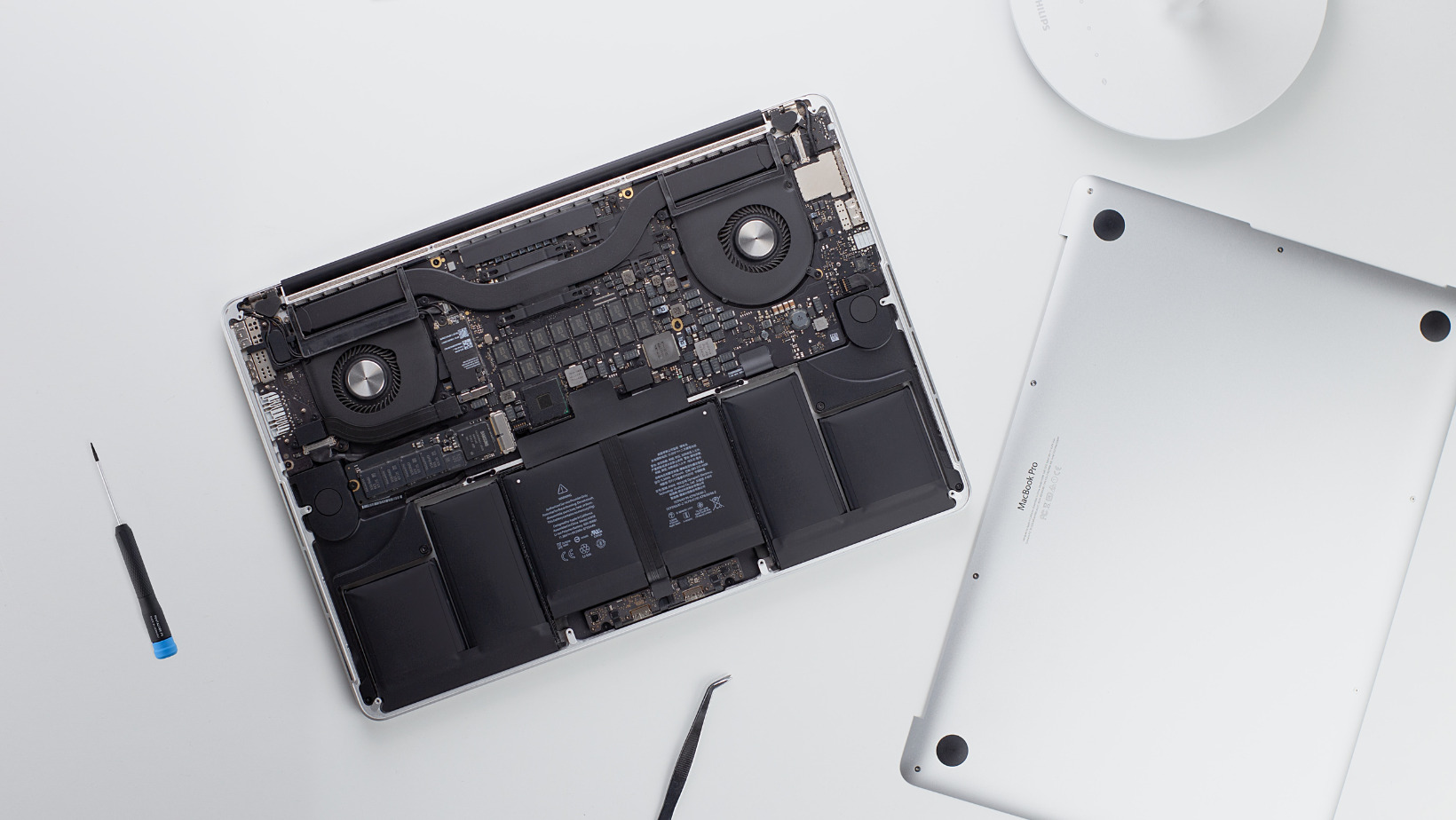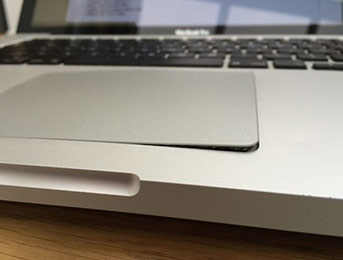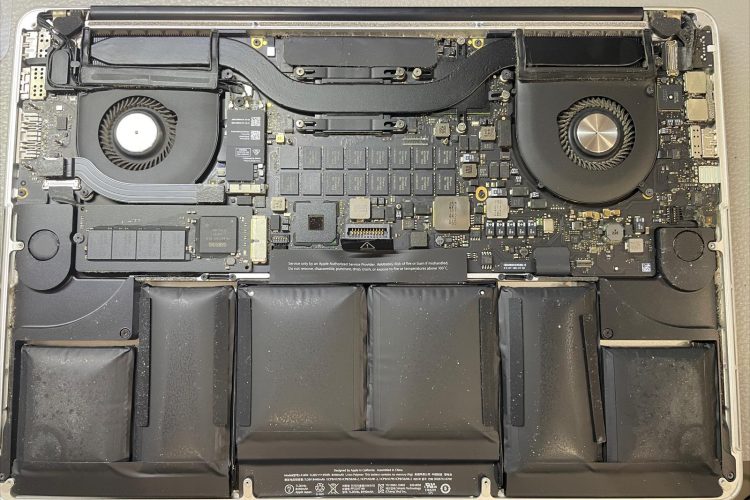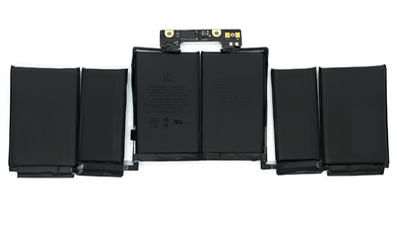
How To Know When to Replace Macbook Pro Battery
Have you been wondering when to replace MacBook Pro battery? Indeed, it’s a crucial question for all MacBook Pro owners. The battery is a key component. Therefore, understanding its lifespan and signs of wear is essential. In this blog post, we’ll explore this topic in detail. From understanding MacBook Pro batteries to recognizing signs of a failing battery. Additionally, we’ll discuss the consequences of not replacing your battery on time. Finally, we’ll guide you through the process of replacing it, whether DIY or at a repair shop. Let’s dive in!
Understanding MacBook Pro Batteries
To start, we need to understand what a MacBook Pro battery is. In essence, it’s the powerhouse of your laptop. It provides the needed energy for your device to function properly. Surprisingly, not everyone knows what constitutes these batteries.
Basically, MacBook Pro batteries are lithium-ion batteries. They are, without a doubt, the heart of the device.
In particular, the lithium-ion technology used in these batteries is notable. It allows for rechargeability, thus providing a lasting source of power for your device. Moreover, the technology is lightweight and efficient, which makes it an ideal choice for portable devices like the MacBook Pro.
However, it’s important to realize that these batteries have a lifespan.
The lifespan is measured in cycles. A cycle is defined as the process of charging a battery from 0% to 100% and then discharging it back to 0%. The more cycles a battery has gone through, the less its capacity to hold charge becomes.
For instance, a brand new MacBook Pro battery typically has a lifespan of about 1000 cycles. After that, its performance can start to decline. This doesn’t mean that the battery will suddenly stop working after 1000 cycles. Rather, it simply means that the battery’s ability to hold a charge will decrease. Consequently, you might start noticing your MacBook Pro’s battery life decreasing over time.
Furthermore, it’s important to point out that the actual lifespan of a MacBook Pro battery can vary.
It depends on various factors such as usage patterns, settings, and the environmental conditions where the laptop is used. For example, exposing your MacBook Pro to extreme temperatures can adversely affect the battery’s lifespan.
Lastly, it’s essential to note that MacBook Pro batteries are integrated into the device. They’re not designed to be easily replaceable by users. In fact, Apple recommends getting battery replacements done by authorized service providers. This ensures that the job is done correctly and safely.
In summary, understanding your MacBook Pro’s battery — its composition, lifespan, and replacement procedure — is key. It equips you with the necessary knowledge to make an informed decision when you start questioning “when to replace MacBook Pro battery”. We will delve into this topic in more detail in the next section.
When to Replace Macbook Pro Battery
1. Performance degradation
Performance degradation is often the first sign that your MacBook Pro battery needs replacement. When your battery health declines, Apple’s macOS system may start reducing the device’s performance. This move is designed to protect the device’s electronic components and to extend the battery’s lifespan. However, it can lead to a noticeable slowdown in your MacBook Pro’s operation.
Here’s how you can check for performance degradation due to a declining battery:
-
Monitor your MacBook Pro’s speed
If you start to notice that your MacBook Pro is taking longer to open applications or files, or if there’s a delay in the response time when you click or type, these could be signs that your device’s performance is being affected by a declining battery.
-
Check Battery Health
Apple includes a Battery Health feature in macOS.
-
- To access it, click on the battery icon in the menu bar while holding the Option (Alt) key.
- Then select ‘Battery Health…’. A window will open, displaying the battery’s condition.
- If it states ‘Normal’, your battery is healthy. If it says ‘Service Recommended’, it means your battery is significantly degraded and may need replacement.
-
System Report
For a more detailed view, you can check the System Information app.
-
- To do this, click on the Apple logo in the top left corner of your screen.
- Then select ‘About This Mac’, and click on ‘System Report…’.
- From there, navigate to ‘Power’ under the ‘Hardware’ section. Here, you can find detailed information about your battery, including its cycle count and condition.
- If the condition is ‘Poor’ or ‘Fair’, it’s a clear sign your battery is declining and may need replacement soon.
Remember, a slower device doesn’t always mean a bad battery. It could be due to other reasons like a full hard drive, too many applications running at once, or an outdated operating system. However, if you’ve ruled out these factors and your device is still slow, it’s worth checking your battery’s health.
2. Battery drains rapidly
If your MacBook Pro’s battery drains rapidly, it could indicate that the battery is declining. When we say “fast” or “rapidly”, we mean that the battery percentage decreases at a quicker rate than it used to. This could be noticeable even when you’re using less resource-intensive applications like browsing the web or writing a document, as opposed to heavy tasks like video editing or gaming.
There isn’t a specific time frame that defines “fast” as it can vary based on your MacBook Pro’s age, model, and usage patterns. However, Apple provides a general guideline on what to expect from a healthy MacBook Pro battery:
- Newer MacBook Pro models (2016 and later): These models are expected to deliver up to 10 hours of battery life when performing tasks like web browsing or watching videos.
- Older MacBook Pro models (2015 and earlier): These models are expected to deliver up to 8-9 hours of battery life for the same tasks.
If your MacBook Pro’s battery life falls significantly short of these estimates, it could be a sign of a weakening battery. Here’s how you can track your battery performance:
- Monitor your battery percentage: Keep an eye on the battery percentage when you’re using your MacBook Pro. If it’s decreasing rapidly even during light usage, it could indicate a problem.
- Check Battery Health: As mentioned earlier, you can check your battery health by holding the Option key and clicking on the battery icon in the menu bar. If it says ‘Service Recommended’, your battery might be weakening.
- Use Activity Monitor: You can use the Activity Monitor app to see if any apps are using a significant amount of power. To do this, open Activity Monitor (you can find it in the Utilities folder), and then click on the ‘Energy’ tab. If an app is using a high amount of energy, it could be causing your battery to drain faster.
Remember, many factors can influence your MacBook Pro’s battery life, including screen brightness, the number of apps running, and even the temperature of the environment you’re in. However, if your battery is draining quickly and you’ve eliminated these factors, it might be time to consider a battery replacement.
3. Battery swelling
Battery swelling in a MacBook Pro occurs when the lithium-ion cells within the battery expand. This usually happens due to overcharging, overheating, or damage. When the cells expand, they push against the casing of the battery, which can cause it to bulge or deform.
This physical change can have noticeable effects on your MacBook Pro. Here’s how you can spot them:
- Deformed casing: The most obvious sign of battery swelling is a deformed casing. This can manifest as the bottom cover of your MacBook Pro bulging out. It can cause the laptop to wobble when placed on a flat surface due to the bulge.
- Trackpad issues: The battery in a MacBook Pro is situated directly beneath the trackpad. When the battery swells, it can push against the trackpad from underneath. This can cause the trackpad to become unresponsive, erratic, or it might not click properly.
- Separation of chassis: In extreme cases, you might notice the chassis (the body of the MacBook Pro) starting to separate. This could appear as gaps opening up between the body panels of your MacBook, especially near the trackpad or the bottom cover.
If you notice any of these signs, it’s important to take action immediately. A swollen battery is a safety hazard. It could potentially leak chemicals or even cause a fire in the most severe cases.
Don’t try to open the MacBook Pro or replace the battery yourself. Instead, stop using the laptop and take it to an Apple Store or an authorized service provider as soon as possible. They have the necessary tools and expertise to safely handle and replace a swollen battery.
4. Unexpected shutdowns
Unexpected shutdowns are a common sign that your MacBook Pro’s battery is declining. Normally, your MacBook Pro should run smoothly until the battery level reaches a very low percentage, usually around 1-2%. It should then enter a low-power state or sleep mode to conserve battery life.
However, if your MacBook Pro shuts down abruptly when the battery level is still relatively high (for instance, 20% or more), it’s a sign that the battery isn’t able to provide a stable power supply. This instability can cause the system to shut down unexpectedly to protect the hardware.
Another symptom of a failing battery is when your MacBook Pro can’t power on without being plugged into a power source.
In this case, your battery may not be able to hold a charge at all. Even if the battery percentage appears to be high when plugged in, it drops to zero or shuts down as soon as you unplug the charger.
Here’s how you can diagnose these issues:
- Monitor unexpected shutdowns: Keep track of when and under what conditions your MacBook Pro shuts down unexpectedly. If it’s happening regularly and at higher battery percentages, it’s a clear sign of battery trouble.
- Test battery independence: Try running your MacBook Pro on battery power alone. Fully charge the battery, unplug the charger, and see how the laptop performs. If it shuts down soon after being unplugged or can’t be turned on without the charger, it indicates a battery issue.
As always, it’s important to consider other factors that could be causing these issues. For instance, unexpected shutdowns can also be caused by software problems or hardware issues unrelated to the battery. However, if you’ve ruled out these possibilities and the problems persist, it’s highly likely your MacBook Pro’s battery needs replacing.
Remember, always consult with a professional or an Apple service center if you’re experiencing these issues. They can run diagnostic tests to confirm whether it’s a battery issue and guide you on the next steps.
Where to replace Macbook Pro battery
Choosing the right place to replace your battery is crucial. After all, it’s about your MacBook’s performance. It’s about its lifespan. Therefore, let’s explore your options.
Firstly, computer repair shops can be a good option. They handle a wide range of issues. This includes battery replacement. One advantage of repair shops is cost. It can be cheaper than authorized service centers. Additionally, they handle out-of-warranty devices.
For example, consider VOLTA PC Upgrade & Repair. They offer MacBook Pro battery replacement. Moreover, they provide free diagnostics. This is a valuable service. It helps identify other potential issues.
On the other hand, there are authorized service centers. They’re another option. But, they may be costlier. Also, they may not serve out-of-warranty devices.
In conclusion, both options have pros and cons.
In the end, the choice depends on your needs. Your budget. Your warranty status. It’s essential to make an informed decision. Your MacBook Pro’s performance is at stake.
The Consequences of Not Replacing Your Battery on Time
Not replacing your MacBook Pro battery has consequences.
One is reduced productivity.
For instance, imagine you’re in a meeting. Suddenly, your MacBook shuts down. The battery is dead. This could disrupt your workflow.
Also, a failing battery can affect your MacBook’s performance. It can cause sudden shutdowns. Moreover, it can slow down your device. Your apps may not run smoothly. Eventually, your MacBook may freeze. This can be frustrating.
Another key point is data loss.
A sudden shutdown can lead to this. Unsaved work might be lost. Important files could be gone. This could have serious repercussions.
Furthermore, there’s a risk of battery swelling.
Old or faulty batteries can do this. It can physically damage your MacBook. The trackpad may become unresponsive. The bottom cover may bulge. In severe cases, it can even lead to a safety hazard.

Now, consider the cost.
You might think, “I’ll just keep my MacBook plugged in.” But that’s not a solution. It’s a temporary fix. It could lead to other issues. For example, it can strain your power adapter. Over time, it may fail. Replacing it is another cost.
Additionally, there’s the cost of data recovery. Lost data can be expensive to recover. Sometimes, it’s not even possible. This is another avoidable expense. Therefore, it’s more cost-effective to replace the battery.
In summary, failing to replace your MacBook battery has consequences. Reduced productivity is one. Performance issues is another. Data loss and physical damage are also possible. Finally, there are the extra costs. All these issues are preventable. Simply replace your battery on time.
To conclude, your MacBook Pro battery is important. Without it, your device won’t work. If the battery fails, it affects your productivity. It can also damage your MacBook. The costs can add up. Therefore, it’s best to replace your battery in time.
How To Replace Your MacBook Pro battery – DIY Tips
Replacing a MacBook Pro battery yourself can be a daunting task. However, with the right tools and guidance, it’s doable. Here, we outline the process. Remember, proceed with caution. Safety first!
- To start with, you’ll need a few items. These include a new battery, a set of screwdrivers, and an anti-static wrist strap. Above all, make sure to buy a battery compatible with your MacBook Pro model.
- Firstly, turn off your MacBook Pro. Next, unplug it from the power source. Now, flip it over. Remove the bottom case using your screwdrivers. This reveals the internals.
- Secondly, locate the battery. It’s the large, rectangular component. To clarify, it’s usually at the front of the device. Be careful here. There may be other wires or components nearby.
- Thirdly, gently disconnect the battery connector. It’s usually on one side of the battery. Once done, remove any screws holding the battery in place. Subsequently, lift the old battery out of the device.
- Next, position the new battery in the battery compartment. Screw it securely into place. Afterwards, reconnect the battery connector. Remember to handle these parts gently.
- Finally, replace the bottom case. Tighten the screws back into place. At this point, you’ve successfully replaced your MacBook Pro battery.
That’s it! You’ve taken on a daunting task and completed it successfully. Now, turn on your MacBook Pro. Check if the new battery is functioning correctly.
However, this DIY method is only recommended if you’re confident in your abilities. It’s indeed a way to save cost. But, it carries risks. If you want to save time and avoid potential mishaps, seek professional help. A reliable computer repair shop, such as VOLTA PC Upgrade & Repair, can help.
FAQs
Q: How do I know if my MacBook Pro battery needs replacing?
A: To determine if your MacBook Pro battery needs replacing, you can check the battery status by clicking on the battery icon in the menu bar. If the battery health shows a significantly reduced maximum capacity or if you experience shorter battery life and frequent shutdowns, it may be a sign that your battery needs replacement.
Q: How long does a MacBook battery last before it needs replacing?
A: The lifespan of a MacBook battery varies depending on several factors, such as usage patterns, settings, and model. Generally, MacBook batteries are designed to retain up to 80% of their original capacity after around 1,000 full charge cycles. This means that on average, a MacBook battery can last several years before it may need replacing.
Q: What is the average lifespan of a MacBook Pro battery?
A: The average lifespan of a MacBook Pro battery is typically around 3 to 5 years. However, this can vary based on individual usage patterns and factors like battery health management settings, temperature, and overall battery care. It’s important to note that battery lifespan can also depend on the specific model of MacBook Pro you own.
Q: How do I check the life cycle of my Mac battery?
A: To check the life cycle of your Mac battery, go to the Apple menu, select “About This Mac,” then click on “System Report.” Under the “Hardware” section, choose “Power,” and you’ll find the “Cycle Count” which indicates the number of charge cycles your battery has undergone. This can give you an idea of how much life your battery has consumed and whether it may be nearing the end of its lifespan.
Conclusion
In conclusion, knowing when to replace MacBook Pro battery is crucial. It affects not only the device’s performance but also its longevity. Whether you choose to replace it yourself or seek professional help, make an informed decision. Consider the signs of a failing battery and the consequences of not addressing it on time. Ultimately, your MacBook Pro is an investment. Take care of it. Make the most of its functionality for as long as you can.
If you’ve realized it’s time to replace your MacBook Pro battery, VOLTA PC Upgrade & Repair in Singapore is ready to assist. They offer a free diagnostic service. Therefore, you can understand the condition of your battery without any upfront costs. Take the first step towards prolonging the life of your MacBook Pro. Contact us today!
Address:
- Tai Seng Branch: 8 Burn Road #01-04, Trivex, Singapore 369977
- Jurong Branch: Blk 132 #01-279C, Jurong Gateway Road, Singapore 600132


